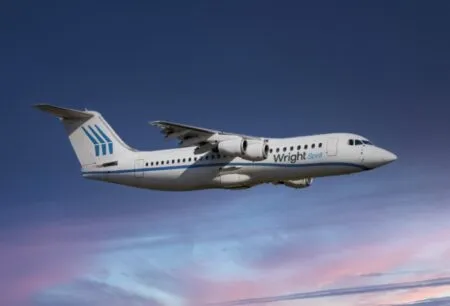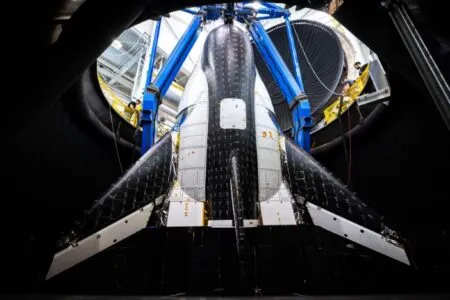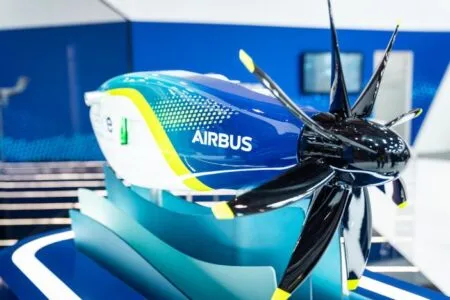Successor to the Perlan 1 research sailplane, in which the late Steve Fossett and Einar Enevoldson captured an altitude record for gliders of 50,722ft (15,460m) in August 2006, the Perlan 2 is designed to fly higher still: exploring the ‘mountain waves’ encountered at 90,000ft (27,500m). In the process, the two-seat sailplane will fly higher than the U-2 and the SR-71 and gather data on climate change and depletion of the ozone layer. It will also give its crew the feeling of what it might be like to fly a winged aircraft over the surface of Mars.
Described as a “spacecraft with glider wings”, the two-seat Perlan 2 represents a major technological and human challenge. Its design brief includes the ability to fly in less than 3% of normal air density and at temperatures of -70°C. To do this, the lightweight aircraft has a wingspan of 84ft (26m), pressurized accommodation for two pilots, provision for a scientific payload, life support equipment and two safety parachutes.
To date, the Perlan 2 has completed one flight, out of Redmond Municipal Airport, Oregon, USA, on September 23, 2015. However, a large amount of data was gathered in advance of this milestone, and tests continue to ensure that the aircraft will behave as expected once at very high altitude. The project did not conduct a wind tunnel test, even with a model. Instead the key piece of simulation was a CFD test phase.
Ground testing and first flight
Ed Warnock, CEO for the Airbus Perlan Mission II project, outlines the next three tests completed on the ground: “The first test we did on the ground was on a duplicate of the cockpit and fuselage section that we tested for pressure and strength. We sealed up the cockpit and pressurized it to 25psi – three times the maximum pressure we expect to see on our missions. We then loaded it up with sandbags and pulled on the fuselage to create the same stresses as for our 6g flight load. The pressure bulkhead failed at exactly 25psi. Later on we tested the wings to 3g, to prove their design and strength were adequate for the first flight. Then after the first flight we did a 5g test on the wings.”
Between the 3g and 5g tests, both of which were successfully concluded, the team completed its first flight with the Perlan 2, with pilots Jim Payne and Morgan Sandercock at the controls. Before taking the sailplane into the air for the first time, the flight controls were tested for the envisaged stick and rudder forces and a handful of ground tows brought the Perlan 2 up to flying speed, ensuring that it tracked straight, that basic control was as expected, and that the brakes worked.
Perlan 2 chief pilot Payne takes up the story: “For the first flight we basically just wanted to prove we could take off and land and get some basic flying qualities data. We made a normal take-off, towed to a height of 5,000ft (1,500m) and then released and did some basic stability checks, dynamic stability checks and turns. We did not intend to stall it on the first flight – stall speed is predicted to be about 33 KIAS [knots indicated airspeed], but we slowed down to 38 KIAS. The airplane was great and we didn’t have any buffets or indications of a stall. It recovered fine and then we came back and landed.”
As this magazine was going to press (November 2015), the Perlan 2 was in San Diego, California, for ground vibration tests. Payne continued: “We have a computer model of the structure and in the ground vibration tests we’ll have accelerometers all over it so that we can look at the structural loads and use the model to predict flutter. So as we do envelope expansion we’ll be doing flutter test points to verify if the dynamic behavior of the structure is as predicted. If not, we’ll try to figure out why not before we get to any airspeed and altitude conditions where we might have flutter conditions – and we want to avoid those at all costs.”
A week into vibration testing, and Payne seemed pleased with progress: “The testing is going very well,” he said. “We will not know the final results until they analyze the data, which will take about three weeks.”
Flight test envelope expansion
Once ground vibration tests are complete, the Perlan 2 will move to Minden, Nevada, where flight trials will continue to expand the envelope, exploiting a wave season that runs from approximately February to May.
“In late November and December [2015] we’ll be using tows and gradually expanding our envelope during systems integration tests. We’ll have the pressurization system installed and we will be testing that the pressurization comes on as desired and behaves as desired at lower altitudes.”
The team will then gradually start to expand the envelope. “Up to 30,000ft (9,100m) our VNE (never exceed speed) is 121 KIAS, and then above 30,000ft our VNE gradually decreases so that at 90,000ft (27,500m) it is 54 KIAS. We use a standard altitude airspeed diagram with the test points scattered around it. At each of these test points we’ll be doing standard flutter and flying quality maneuver blocks.”
The team is currently working on a data acquisition system for the sailplane. An inertial measuring unit will be used to gather dynamic data, and other instrumentation will measure load distribution and other factors. Payne considers expansion of the flutter envelope to be the most important flight test element.
“Because we are going so high, we are going to get some really high true airspeeds. Even though our indicated airspeed is pretty low, at 90,000ft you get 6.7kts true airspeed for each knot of indicated airspeed. So that’s going to be an interesting situation because we’ll have really high true airspeed and really high wind speed in the wave. When you’re climbing, they sort of balance each other out which makes it kind of easy, like an elevator ride, but when you turn downwind you’re going very fast.” Ultimately the team hopes to have a real-time data-gathering capability for monitoring flutter data.
One of the biggest challenges for the project is its dependence on the weather. The team is confident of being able to routinely reach an altitude of around 30,000ft in the waves around Minden. If things go well, the sailplane could get to around 40,000ft. Around 10 hours of flying at 30,000ft and above will be sufficient to verify the cabin pressurization and the oxygen rebreather system.
Unique challenges
The provision of a rebreather is very likely a first for a sailplane, and its use reflects concerns for both safety and keeping the weight of the sailplane to a minimum. “By taking the carbon dioxide out and rebreathing the air, we will be using 100% of the oxygen we take out of the tank,” Warnock says. “That means we can have a smaller tank. One of the attractions is simply that the weight of the rebreather system is lighter than a standard oxygen system.”
While weight is a key factor to take into account, Payne considers that the aircraft’s power requirements are just as big a problem to overcome. “We have just 100A of battery power. Meanwhile, we have a new inertial measuring unit weighing less than a couple of kilograms. So we are installing maybe a total of only 10-15 lb (4.5-7kg) of test equipment in the aircraft. Compared with the maximum 1,800 lb (800kg) expected flying weight, it’s insignificant.”
The next phase of the flight test program will take the glider to Argentina in 2016, where it will be able to benefit from the effect of the polar vortex, which pushes the mountain waves above the troposphere and into the stratosphere. It is these waves that will be responsible for taking the Perlan 2 to its planned record altitude – all the way to 90,000ft. For Warnock, the most important thing before the team goes to Argentina is gaining enough flight experience at altitude to confirm that the pressurization and life-support systems work and that the aircraft has the predicted handling and stability qualities.
Volunteer effort
Airbus Perlan Mission II is clearly an innovative project, not just in terms of technology but also in how it is being run as a non-profit, volunteer-led effort. Daniel Werdung, spokesman for Airbus Group, highlights the “pioneer enthusiasm” behind the project but doesn’t see it as a model for future research by the company. “Currently we think this is a great project and we want to support the people working there,” he says. “We don’t see it as a prototype. We just want to promote this project and see the research they can do, and then we will see where we take it. Right now it is about enthusiasm, research and the testing – pushing the limits.”
Once the Perlan 2 is operating at very high altitude, the data gathered may well contribute to the dream of flying a winged aircraft on Mars.
“The data we are gathering will be approximately equivalent in the flight regime to a flight on Mars,” Warnock explains. “The air densities and temperatures will be approximately equivalent. We will be sharing that data with universities and much of it will go into the public domain to enrich and excite exploration in very thin atmospheres. Airbus Group will be sponsoring that data and we hope to give it wide distribution so that it can be used by researchers doing projects that may see flight on Mars. We want to make sure that data is available to aerospace engineers and researchers all over the world.”
Following the ground vibration tests, it is likely that the Perlan 2 will start flying again at Minden in early December 2015. And once flight testing in Nevada is complete, the aircraft will move to Argentina.
For chief pilot Payne, the biggest challenge at that point is going to be the weather. “There are a lot of unknowns about the polar vortex,” he admits. “We have got models that the meteorological community has built and I am hoping they are all accurate. But we won’t know until we go out there and fly. It’s going to be a lot of fun comparing the predictions with what we find.”
Thomas Newdick is an aviation and defense writer based in Berlin, Germany




